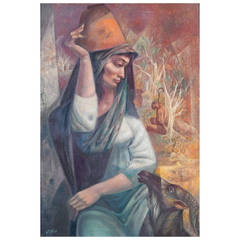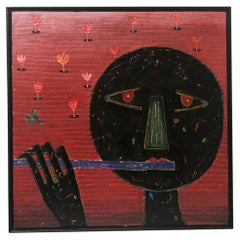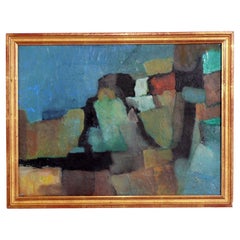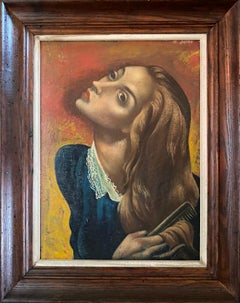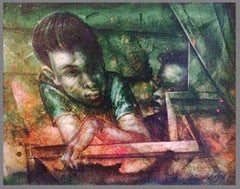Michael Lenson
American, 1903-1971
Michael Lenson was born in Russia in 1903. He is a Russian-American painter who won a prize at the National Academy of Design and exhibited at several New York galleries, before becoming the director of WPA mural projects in New Jersey in the 1930s. Lenson painted a set of murals on the history of Newark for City Hall, including scenes showing industries such as tanning and iron casting.
to
1
1
1
1
Mid Century Painting with "Song of Solomon" Theme, by Lenson
By Michael Lenson
Located in Philadelphia, PA
Entitled "Return, Return, O Shulemite," with a scene taken from the Song of Solomon, this painting depicts the legendary wife of King Solomon, who was ...
Category
1950s American Mid-Century Modern Vintage Michael Lenson
Related Items
Mid Century Painting of a Flute Player
Located in Tampa, FL
Listed artist, K. Muralidharan painting of a figure playing a flute. Mid century.
Category
Mid-20th Century Michael Lenson
Materials
Paint
Abstract Mid Century Painting
Located in Atlanta, GA
Original Abstract Mid Century Painting, artist unknown, believed to be American, circa 1960s. It has been recently professionally framed i...
Category
1960s American Mid-Century Modern Vintage Michael Lenson
Materials
Canvas, Wood
Mid Century Batik Painting of Nude with Flower
Located in Miami, FL
Beautiful Batik painting of a nude in a landscape holding a flower.
Category
1950s Malaysian Vintage Michael Lenson
Materials
Fabric
Selection of Mid-Century Jazz Themed Paintings
Located in Atlanta, GA
Selection of Mid-Century jazz themed paintings, American, circa 1930s-1970s. From left to right, they are:
1) New Orleans jazz watercolor by Leo Meirsdorff...
Category
1960s American Mid-Century Modern Vintage Michael Lenson
Materials
Canvas, Paper
Set of Six Vintage Paintings with Minstrel Scenes from the Manesse Song Manuscri
Located in Berghuelen, DE
Set of Six Vintage Paintings with Minstrel Scenes from the Manesse Song Manuscript
A set of six paintings depicting minstrel scenes from the mane...
Category
Mid-20th Century German Gothic Michael Lenson
Materials
Wood
H 8.27 in W 6.3 in D 1.19 in
Portrait of a Handsome Man Oil Painting by Mid Century Artist
Located in Palm Springs, CA
This beautiful mid century painting of a handsome man was painted in the 1950s. The subject was the owner of a beautiful San Diego Estate. Artist was F Stanley Herring. Beautiful antique fold leaf frame with ruby color fillet trim. Subject is seated in a royal blue chair...
Category
1950s North American Mid-Century Modern Vintage Michael Lenson
Materials
Canvas
19th Century Theatre Themed Limoges Enamel Painting
Located in London, GB
This charming enamel painting shows a gentleman, centrally positioned, being led by two women, one on each arm. The woman on his left has a troubled expression, her hair is grey, and she wears a dark red shawl and green costume, with a knife stored under her belt. She points up to the sky with her left hand. By comparison, the woman on the gentleman’s right looks cheerful, she has youthful blond hair, and is clad in a pink and white dress...
Category
19th Century French George II Antique Michael Lenson
Materials
Enamel
Mid-Century American Oil Painting Portrait of a Woman Painting a Boat
Located in New York, NY
Mid-Century American oil painting portrait depicts a woman in a yellow jumpsuit pausing for raindrops while painting the underside of a boat on a dock,...
Category
20th Century American Mid-Century Modern Michael Lenson
Materials
Metal
Mid-Century Modernist Painting of a Greek Village
Located in Redding, CT
Mid-Century Modernist painting of a Greek village. Reminiscent of Greece or Eastern Europe. Nice modernist or cubist feel. Signed illegibly C. Man.
Category
1960s Mid-Century Modern Vintage Michael Lenson
Materials
Canvas, Wood, Paint
Set of Three 1960s Themed Race Car Paintings
Located in Ferndale, MI
Possibly Illustration Art, signature not showing as matted.
One image is notated Jack Brabham in 1961 Cooper Climax.
Second notated Tony Brooks 1958 Vau...
Category
1960s American Vintage Michael Lenson
French Mid Century Painting Still Life with Coffee Pot by Poulain, 1950
By Michel-Marie Poulain
Located in Antwerp, BE
Mid century painting still life with coffee pot, bottle and fruit on a table by Michel Marie Poulain France, 1906-1991 Watercolor & gouache. Woo...
Category
Mid-20th Century French Mid-Century Modern Michael Lenson
Materials
Paint
H 23.63 in W 29.73 in D 0.99 in
Mid Century Abstract Painting
Located in Los Angeles, CA
English mid-century Abstract Expressionist oil on canvas painting with a Hans Hoffman-like feel. Powerful gestural lines and a unique use of color blocking create balance . The mood...
Category
20th Century English Mid-Century Modern Michael Lenson
Materials
Canvas
Previously Available Items
Combing
By Michael Lenson
Located in Los Angeles, CA
Early work by American artist Michael Lenson.
Category
1950s Art Deco Michael Lenson
Materials
Oil, Panel
Under Stairs
By Michael Lenson
Located in Los Angeles, CA
MICHAEL LENSON
"UNDER THE STAIRS"
ACRYLIC ON CANVAS, SIGNED
AMERICAN, C.1960
16 X 20 INCHES
Michael Lenson
1903-1971
Michael Lenson was born in Galich, a Russian city of 25,000 situated on the eastern slopes of the Ural Mountains. “In winter, peasants from the north packed their horse-drawn sleighs with kindling and drove into the town across frozen Lake Galich,” Lenson later recalled. “Haggard monks paraded through the town carrying icons, then banged on our door to solicit alms. Wolves roamed through the streets in the dead of winter, and the Tsar and his family stopped their private railway car at the Galich station every summer to receive gifts of locally made leather boots from the local town officials.”
Although Lenson and his family emigrated to New York when he was only seven years old, those vivid childhood memories stayed with him, and may have sparked the dream-infused imagery in his paintings and drawings.
By 1928, Lenson was a struggling art student sharing a coldwater flat on East 116th Street in New York City flat with fellow artists Louis Guglielmi (1906-1956) and Gregorio Prestopino (1907-1984). He studied at the National Academy of Design and sketched at the Metropolitan Museum. To keep meat on his bones, Lenson was working in the Post Office at night, and airbrushing shoes for mail-order catalogs during the day. But that year, Lenson’s life changed dramatically when he was awarded the much-coveted $10,000 Chaloner Prize for Painting.
“It was fantastic, absolutely fantastic,” Lenson later told an interviewer for the Smithsonian’s Oral History Project. “All of a sudden my worries fell away and I was aboard ship. All my relatives who considered me a no-good deficit to the family were on the dock waving farewell to me.”
Thus the Russian born artist was able to return to Europe for four years of travel and study. At the University of London’s Slade School of Art, Lenson logged long months sitting at a drafting table, mastering the drawing skills that would remain a hallmark of his work. “You could say that the instruction there was academic,” he later recalled, “but boy, did they know their stuff.” While in London, Lenson also assisted the noted muralist Colin Gill.
Moving on to Paris, Lenson occupied a Chaloner-funded apartment near the Jardin de Luxembourg. He enrolled in the Académie des Beaux-Arts, and began to paint large figurative canvases that were strongly influenced by the old master works that he studied at the Louvre. Beyond studying, Lenson made the most of his years in Paris. He and a circle of American expatriates congregated at Le Dôme Café in the evenings for camaraderie and drinks. He heard Chaliapin sing and saw Ravel conduct. He escorted glamorous women, including Henrietta Schumann, the phenomenal young Russian-American concert pianist who had just arrived in Paris to study with Alfred Cortot...
Category
1960s Modern Michael Lenson
Materials
Canvas, Oil
TERRIBLE WITH BANNERS"
By Michael Lenson
Located in Los Angeles, CA
MICHAEL LENSON
"TERRIBLE WITH BANNERS"
OIL ON MASONITE, SIGNED, TITLED
AMERICAN, C.1959
42 X 28.5 INCHES
Michael Lenson
1903-1971
Michael Lenson was born in Galich, a Russian city of 25,000 situated on the eastern slopes of the Ural Mountains. “In winter, peasants from the north packed their horse-drawn sleighs with kindling and drove into the town across frozen Lake Galich,” Lenson later recalled. “Haggard monks paraded through the town carrying icons, then banged on our door to solicit alms. Wolves roamed through the streets in the dead of winter, and the Tsar and his family stopped their private railway car at the Galich station every summer to receive gifts of locally made leather boots from the local town officials.”
Although Lenson and his family emigrated to New York when he was only seven years old, those vivid childhood memories stayed with him, and may have sparked the dream-infused imagery in his paintings and drawings.
By 1928, Lenson was a struggling art student sharing a coldwater flat on East 116th Street in New York City flat with fellow artists Louis Guglielmi (1906-1956) and Gregorio Prestopino (1907-1984). He studied at the National Academy of Design and sketched at the Metropolitan Museum. To keep meat on his bones, Lenson was working in the Post Office at night, and airbrushing shoes for mail-order catalogs during the day. But that year, Lenson’s life changed dramatically when he was awarded the much-coveted $10,000 Chaloner Prize for Painting.
“It was fantastic, absolutely fantastic,” Lenson later told an interviewer for the Smithsonian’s Oral History Project. “All of a sudden my worries fell away and I was aboard ship. All my relatives who considered me a no-good deficit to the family were on the dock waving farewell to me.”
Thus the Russian born artist was able to return to Europe for four years of travel and study. At the University of London’s Slade School of Art, Lenson logged long months sitting at a drafting table, mastering the drawing skills that would remain a hallmark of his work. “You could say that the instruction there was academic,” he later recalled, “but boy, did they know their stuff.” While in London, Lenson also assisted the noted muralist Colin Gill.
Moving on to Paris, Lenson occupied a Chaloner-funded apartment near the Jardin de Luxembourg. He enrolled in the Académie des Beaux-Arts, and began to paint large figurative canvases that were strongly influenced by the old master works that he studied at the Louvre. Beyond studying, Lenson made the most of his years in Paris. He and a circle of American expatriates congregated at Le Dôme Café in the evenings for camaraderie and drinks. He heard Chaliapin sing and saw Ravel conduct. He escorted glamorous women, including Henrietta Schumann, the phenomenal young Russian-American concert pianist who had just arrived in Paris to study with Alfred Cortot.
Lenson later said that when he returned to New York in 1932, “I was no longer the conquering hero. I came back to nothing . . . absolutely nothing.”
Although the Great Depression was dawning, Lenson’s first one-man exhibition at the Caz-Delbo Gallery was a notable success. In a review in the April 30, 1933 New York Times, distinguished critic Howard Devree wrote:
“He stands at the beginning of a very promising career, without close allegiance to any of the great names or schools. Yet in the best sense of the word he is traditional . . . The best of his things strike a good working balance between [color and form]. His figure studies . . . show him at his best . . . His still life is restrained both in color and form - refinement without academicism. The portraits show a sympathy with the old masters of the French school and yet are thoroughly modern. His landscapes are well worked out and lighted. His later things give evidence of growing freedom in the use of clear, rich color and of gathering powers of simplification.”
Margaret Breuning, another noted critic, said of Lenson’s work in her review in the New York Evening Post on May 1, 1933:
“He is a young artist who works in the tradition, particularly in his excellent portraits, but is finding a growing power to enrich tradition with personal expression . . . All the work has an integrity and soundness which warrant a belief in the artist’s future performance.”
Such interviews did not feed artists in those bleak Depression days. Before long, Lenson found his way to New Jersey, where he joined the Federal Arts Project and quickly secured a mural commission for an immense wall in a tuberculosis hospital in Verona, New Jersey and soon painted murals for the New Jersey Pavilion of the 1939 World’s Fair. By then, Lenson had been appointed supervisor for all WPA mural projects in the State. Other mural commissions followed, including his eight-panel “History of Newark” in the City Council Chambers at Newark City Hall and his “Enlightenment of Man” panoramic mural in Weequahic High School in Newark. Another extant Lenson mural is “Mining,” completed for the U.S. Post Office in Mount Hope, West Virginia. Who Was Who In American Art? calls Lenson, “New Jersey’s most important muralist.” Recently, Lenson’s remarkable contributions to WPA art were covered extensively by Nick Taylor in his book, American Made: The Enduring Legacy of the WPA.
After the demise of the WPA, Lenson bought a studio home in Nutley, a town seven miles north of Newark. He married June Rollar, an aspiring poet, and had two sons. Later, he taught painting at Rutgers University and the Montclair Art Museum. During the last sixteen years of his life, Lenson served as art critic for The Newark Sunday News.
Michael Lenson’s paintings are in numerous private collections and in the permanent collections of many institutions, including the Johnson Museum at Cornell University, the Princeton University Art Museum, the Maier Museum of American Art, and the Quick Center for the Arts at Saint Bonaventure...
Category
1950s Surrealist Michael Lenson
Materials
Masonite, Oil
Under the Stairs
By Michael Lenson
Located in Los Angeles, CA
MICHAEL LENSON
"UNDER THE STAIRS"
ACRYLIC ON CANVAS, SIGNED
AMERICAN, C.1960
16 X 20 INCHES
Michael Lenson
1903-1971
Michael Lenson was born in Galich, a Russian city of 25,00...
Category
1960s American Modern Michael Lenson
Materials
Canvas, Acrylic
Under the Stairs
By Michael Lenson
Located in Los Angeles, CA
MICHAEL LENSON
"UNDER THE STAIRS"
ACRYLIC ON CANVAS, SIGNED
AMERICAN, C.1960
16 X 20 INCHES
Michael Lenson
1903-1971
Michael Lenson was born in Galich, a Russian...
Category
1950s American Modern Michael Lenson
Materials
Acrylic, Canvas
Portrait of a Woman
By Michael Lenson
Located in Los Angeles, CA
MICHAEL LENSON
"PORTRAIT OF WOMAN"
OIL ON CANVAS, SIGNED
AMERICAN, DATED 1942
30 X 23 INCHES
Michael Lenson
Michael Lenson was born in 1903 in Galich, Russia. He em...
Category
1940s American Realist Michael Lenson
Girl with Guitar
By Michael Lenson
Located in Los Angeles, CA
MICHAEL LENSON
"GIRL WITH GUITAR"
PASTEL, SIGNED
AMERICAN, C.1935
22 X 18 INCHES
Michael Lenson
1903-1971
Michael Lenson was born in Galich, a Russian city of 25,000 situated on the eastern slopes of the Ural Mountains. “In winter, peasants from the north packed their horse-drawn sleighs with kindling and drove into the town across frozen Lake Galich,” Lenson later recalled. “Haggard monks paraded through the town carrying icons, then banged on our door to solicit alms. Wolves roamed through the streets in the dead of winter, and the Tsar and his family stopped their private railway car at the Galich station every summer to receive gifts of locally made leather boots from the local town officials.”
Although Lenson and his family emigrated to New York when he was only seven years old, those vivid childhood memories stayed with him, and may have sparked the dream-infused imagery in his paintings and drawings.
By 1928, Lenson was a struggling art student sharing a coldwater flat on East 116th Street in New York City flat with fellow artists Louis Guglielmi (1906-1956) and Gregorio Prestopino (1907-1984). He studied at the National Academy of Design and sketched at the Metropolitan Museum. To keep meat on his bones, Lenson was working in the Post Office at night, and airbrushing shoes for mail-order catalogs during the day. But that year, Lenson’s life changed dramatically when he was awarded the much-coveted $10,000 Chaloner Prize for Painting.
“It was fantastic, absolutely fantastic,” Lenson later told an interviewer for the Smithsonian’s Oral History Project. “All of a sudden my worries fell away and I was aboard ship. All my relatives who considered me a no-good deficit to the family were on the dock waving farewell to me.”
Thus the Russian born artist was able to return to Europe for four years of travel and study. At the University of London’s Slade School of Art, Lenson logged long months sitting at a drafting table, mastering the drawing skills that would remain a hallmark of his work. “You could say that the instruction there was academic,” he later recalled, “but boy, did they know their stuff.” While in London, Lenson also assisted the noted muralist Colin Gill.
Moving on to Paris, Lenson occupied a Chaloner-funded apartment near the Jardin de Luxembourg. He enrolled in the Académie des Beaux-Arts, and began to paint large figurative canvases that were strongly influenced by the old master works that he studied at the Louvre. Beyond studying, Lenson made the most of his years in Paris. He and a circle of American expatriates congregated at Le Dôme Café in the evenings for camaraderie and drinks. He heard Chaliapin sing and saw Ravel conduct. He escorted glamorous women, including Henrietta Schumann, the phenomenal young Russian-American concert pianist who had just arrived in Paris to study with Alfred Cortot.
Lenson later said that when he returned to New York in 1932, “I was no longer the conquering hero. I came back to nothing . . . absolutely nothing.”
Although the Great Depression was dawning, Lenson’s first one-man exhibition at the Caz-Delbo Gallery was a notable success. In a review in the April 30, 1933 New York Times, distinguished critic Howard Devree wrote:
“He stands at the beginning of a very promising career, without close allegiance to any of the great names or schools. Yet in the best sense of the word he is traditional . . . The best of his things strike a good working balance between [color and form]. His figure studies . . . show him at his best . . . His still life is restrained both in color and form - refinement without academicism. The portraits show a sympathy with the old masters of the French school and yet are thoroughly modern. His landscapes are well worked out and lighted. His later things give evidence of growing freedom in the use of clear, rich color and of gathering powers of simplification.”
Margaret Breuning, another noted critic, said of Lenson’s work in her review in the New York Evening Post on May 1, 1933:
“He is a young artist who works in the tradition, particularly in his excellent portraits, but is finding a growing power to enrich tradition with personal expression . . . All the work has an integrity and soundness which warrant a belief in the artist’s future performance.”
Such interviews did not feed artists in those bleak Depression days. Before long, Lenson found his way to New Jersey, where he joined the Federal Arts Project and quickly secured a mural commission for an immense wall in a tuberculosis hospital in Verona, New Jersey and soon painted murals for the New Jersey Pavilion of the 1939 World’s Fair. By then, Lenson had been appointed supervisor for all WPA mural projects in the State. Other mural commissions followed, including his eight-panel “History of Newark” in the City Council Chambers at Newark City Hall and his “Enlightenment of Man” panoramic mural in Weequahic High School in Newark. Another extant Lenson mural is “Mining,” completed for the U.S. Post Office in Mount Hope, West Virginia. Who Was Who In American Art? calls Lenson, “New Jersey’s most important muralist.” Recently, Lenson’s remarkable contributions to WPA art were covered extensively by Nick Taylor in his book, American Made: The Enduring Legacy of the WPA.
After the demise of the WPA, Lenson bought a studio home in Nutley, a town seven miles north of Newark. He married June Rollar, an aspiring poet, and had two sons. Later, he taught painting at Rutgers University and the Montclair Art Museum. During the last sixteen years of his life, Lenson served as art critic for The Newark Sunday News.
Michael Lenson’s paintings are in numerous private collections and in the permanent collections of many institutions, including the Johnson Museum at Cornell University, the Princeton University Art Museum, the Maier Museum of American Art, and the Quick Center for the Arts at Saint Bonaventure...
Category
1930s American Modern Michael Lenson
Materials
Pastel
PORTRAIT OF FRANCIS HEALY
By Michael Lenson
Located in Los Angeles, CA
Category
Michael Lenson
Materials
Canvas, Oil
Kite Flyers
By Michael Lenson
Located in Los Angeles, CA
Category
Michael Lenson
Materials
Oil, Canvas
SAILOR'S STORY
By Michael Lenson
Located in Los Angeles, CA
Category
Michael Lenson
Materials
Canvas, Oil
Woman with Guitar
By Michael Lenson
Located in Los Angeles, CA
Category
1930s Michael Lenson
Materials
Canvas, Oil
Michael Lenson furniture for sale on 1stDibs.
Michael Lenson furniture are available for sale on 1stDibs. There are many options to choose from in our collection of Michael Lenson furniture, although gray editions of this piece are particularly popular. Many of the original furniture by Michael Lenson were created in the mid-century modern style in united states during the 1950s. If you’re looking for additional options, many customers also consider furniture by John B. Lear, George Renouard, and Raoul Pene du Bois. Prices for Michael Lenson furniture can differ depending upon size, time period and other attributes — on 1stDibs, these items begin at $9,500 and can go as high as $9,500, while a piece like these, on average, fetch $9,500.
